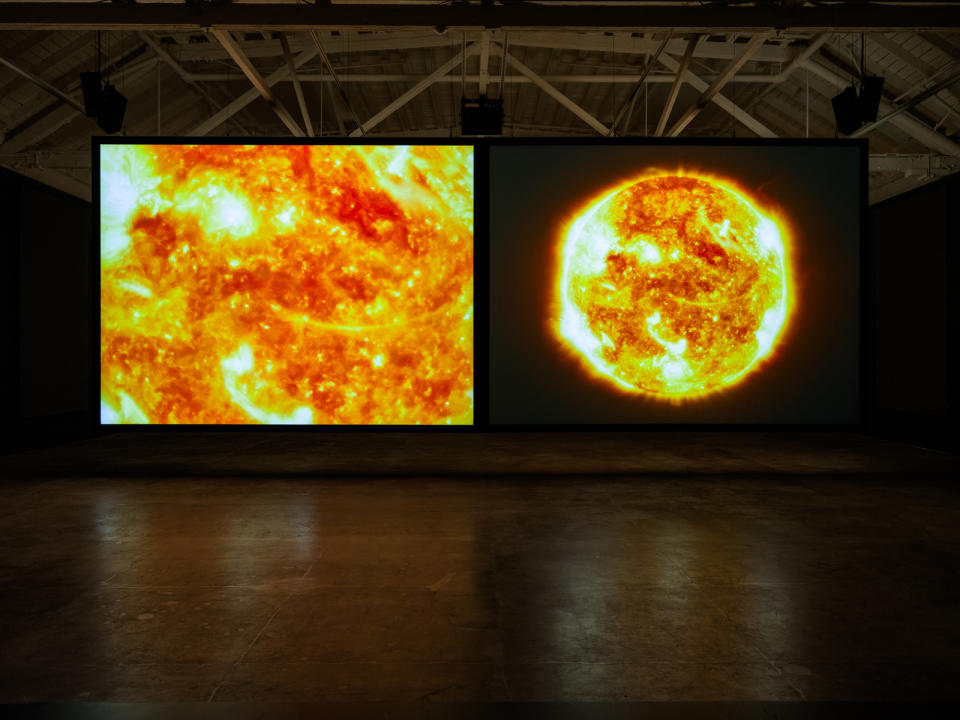Steve McQueen Erases Al Jolson’s Blackface in New Film at L.A.’s Newly Opened Marian Goodman Gallery

Long-time New York and Paris gallery Marian Goodman has opened in Los Angeles with a show of director and artist Steve McQueen’s short film, Sunshine State. Shown on two back-to-back screens in a capacious room, the work finds McQueen training his artistic vision on the history of blackface in Hollywood. The 30-minute piece includes footage of the late actor Al Jolson in blackface in the 1927 film The Jazz Singer, considered the first feature-length movie with synchronized dialogue and the winner of an Academy Award for best adapted screenplay.
McQueen included the scenes from The Jazz Singer in Sunshine State after the movie’s copyright expired on Jan. 1, 2023. “It’s been about 20 years that I’ve wanted to work with this material,” McQueen told AnOther Magazine at International Film Festival Rotterdam where Sunshine State premiered in January. “I wanted to work with it because I wanted to erase Al Jolson.”
More from The Hollywood Reporter
Steve McQueen Fuses Wartime Amsterdam and Modern-Day Extremism in 'Occupied City' Trailer
Ann Philbin to Retire as Director of the Hammer Museum in 2024
The Terrible Toll of the Hollywood Blacklist Explored in New Skirball Show
On view through Nov. 4 at the new Marian Goodman Gallery (located in Hollywood at 1120 Seward Street), McQueen’s film literally erases Jolson and his troubling use of blackface by reversing the scenes so that the black makeup is wiped away; at times Jolson appears headless.
McQueen — director of 2013’s Oscar-winning film 12 Years A Slave as well as the upcoming documentary Occupied City — juxtaposes the Jolson scenes and images of blazing suns with his own narration in which he relates a deeply personal story about his father, who was born in the Caribbean and went to Florida as a young man in the 1950s to work as an orange picker. As McQueen tells it in Sunshine State, his dad went out to a bar at night with two other workers where they were refused service. McQueen’s father ran for safety and hid in a ditch for hours. As he hid, he heard the sounds of gunfire in what he could only assume was the murder of his two acquaintances.

“The incident had obviously shaped his entire life, of what could have been and what was — the fragility of life for him as a Black man,” says McQueen in the film. “He was always cautious. He was always looking out for me. Sometimes, I felt that my father was holding me back, but I didn’t realize until then when he told me the story, he was holding me tight.” Also on view at the gallery is McQueen’s Moonlit, 2016, a sculptural work of two marble rocks in metallic finish.
The exhibition of McQueen’s short film will be followed this fall by a solo exhibition of work by Cristina Iglesias, which will mark her first major show in Los Angeles. Later this winter, the gallery will present exhibits of work by Hiroshi Sugimoto and Tony Cragg.
The new gallery space, designed by L.A.-based architecture firm Johnston Marklee, sprawls over 13,000 square feet, combining two formerly industrial buildings, and it includes a large outdoor garden. Next year, Marian Goodman in New York will also move from its current West 57th Street location to a new site in a historic building in TriBeCa.

“Marian Goodman Gallery has always been a mission-driven gallery, with a primary goal of serving as an intellectual forum advancing the creative practices of our artists over the long term. Complementing our ongoing programs in New York and Paris, our new home in Los Angeles will be a dynamic space of education and exchange within one of the most important arts communities in the world,” said Philipp Kaiser, the gallery’s president and partner, in a statement.
Marian Goodman Gallery is among the latest wave of international and New York-based galleries to open outposts in Los Angeles including David Zwirner, Pace, Sean Kelly and Lisson.
Best of The Hollywood Reporter

 Yahoo News
Yahoo News 
